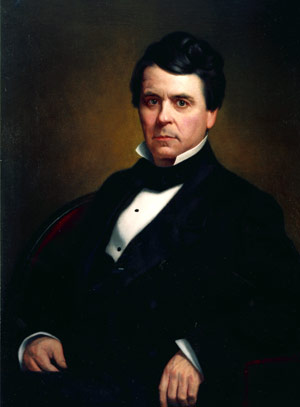Governor James Pollock
Term
January 16, 1855 - January 19, 1858
Affiliation
Whig and Republican
Born
September 11, 1810
Died
April 19, 1890
 Photo courtesy of Capitol Preservation
Photo courtesy of Capitol PreservationCommittee and John Rudy Photography
Biography
It was at the suggestion of James Pollock that the motto "In God We Trust" is stamped on coins of the United States. Pollock was born September 11, 1810 in Milton, Northumberland County, son of Scots-Irish Presbyterian parents, William Pollock (1769-1817) and Sarah Wilson (1771-1865). Not yet six years old when his father died in 1817, Pollock's mother, who lived to age ninety-four, managed to educate seven children. The future governor, after attending Milton Classical Academy, received a bachelor's degree, with highest honors, and a master of arts degree, both from the College of New Jersey at Princeton. He studied law with Samuel Hepburn before setting up a law practice in Northumberland County in 1833.
While serving as Northumberland County district attorney from 1836 to 1838, he married Sarah Ann Hepburn in 1837, eventually raising three sons and five daughters. An appointment as common pleas judge followed and in 1844 he was elected to Congress. Pollock urged Congress to support a transcontinental railroad to the Pacific and, as a friend of Samuel F. B. Morse, the construction of a telegraph line. After three successive terms in Congress, he was appointed Pennsylvania's Eighth Judicial District president judge, in 1850. During his judicial tenure, an amendment to the state constitution began requiring judges to submit to public elections, which Pollock declined.
The Whigs nominated him for governor in 1854, and he was also supported by the Nativist "Know-Nothings," who opposed the Kansas-Nebraska Act, and by temperance advocates. The Kansas-Nebraska Act was opposed primarily because it repealed anti-slavery provisions of the Missouri Compromise. Governor William Bigler attempted to avoid the issue of slavery, as the state Democrats refused to give their endorsement to his party's appeasement of Southern Democrats by allowing slavery into new U.S. territories. However, the Whigs successfully exploited the issue and defeated Bigler by a 55 to 45 percent voter margin. Pollock also disapproved of alcohol and card playing, but when these four disparate groups gained large blocks in the General Assembly, legislative activities were hindered by their strife.
Pollock's most notable milestone of his administration was the sale, in 1857, of the western division of the State Works—consisting of canals and the Allegheny Portage Railroad-to the Pennsylvania Railroad, which had opened its own line to Pittsburgh in 1854 after opening the famous Horseshoe Curve crossing in the Allegheny Mountains near Altoona. This began Pennsylvania's process of liquidating the expensive and increasingly obsolete State Works. The canals were by then operating at a continual deficit and the operation was racked by corruption. The sale greatly reduced the state debt, allowing Pollock to reduce taxes. Governor Pollock also brought about the Normal School Act of 1857, which brought about regional teacher training institutions throughout the Commonwealth, the charter for the Farmer's High School (the institution that would grow into the Pennsylvania State University), creation of a secretary of Common Schools, and purchase of the first governor's mansion at 111 South Second Street in Harrisburg that would be the official home of two governors, Packer and Curtin. Until then, governors rented or purchased their own residences.
When the Panic of 1857 struck the economy, there were mounting bank and business failures, unemployment, and concerns about possible winter riots and martial law. Pollock called a special legislative session that convened on election day and pushed through a temporary suspension of the requirement that banks pay their depositors and those who held their bank notes in gold or silver, thus preventing more bank failures as well as protecting the credit rating of Pennsylvania. However, Pollock found the chief executive's duties so unpleasant to him that he refused to run for reelection. Like most Whigs, Pollock later became a Republican and although he would not again seek elected office, he continued public service for nearly another three decades.
In 1861, Pollock was chairman of the Pennsylvania delegation to the Washington Peace Convention, which failed to prevent the Civil War. That same year President Abraham Lincoln appointed him director of the United States Mint in Philadelphia. He served from 1861 to 1866 and then was reappointed by President Ulysses S. Grant in 1869. From 1873 to 1879, he was elevated to superintendent of the Mint when the U.S. Mint became part of the U.S. Department of the Treasury. Pollock's leadership at the Mint led to adopting his suggestion for the "In God We Trust" motto on U. S. coins. He also served as the naval officer in charge of U.S. Customs in Philadelphia and was the federal chief supervisor of elections in 1886. The former governor was a trustee of Lafayette College and a founder and trustee of the Pennsylvania Military College.
Pollock died in Lock Haven on April 19, 1890, and is interred in Milton Cemetery in the town of his birth.
Pages in this Section
- 1790-1876
- Thomas Mifflin
- Thomas McKean
- Simon Snyder
- William Findlay
- Joseph Hiester
- John Andrew Shulze
- George Wolf
- Joseph Ritner
- David Rittenhouse Porter
- Francis Rawn Shunk
- William Freame Johnston
- William Bigler
- James Pollock
- William Fisher Packer
- Andrew Gregg Curtin
- John White Geary
- John Frederick Hartranft